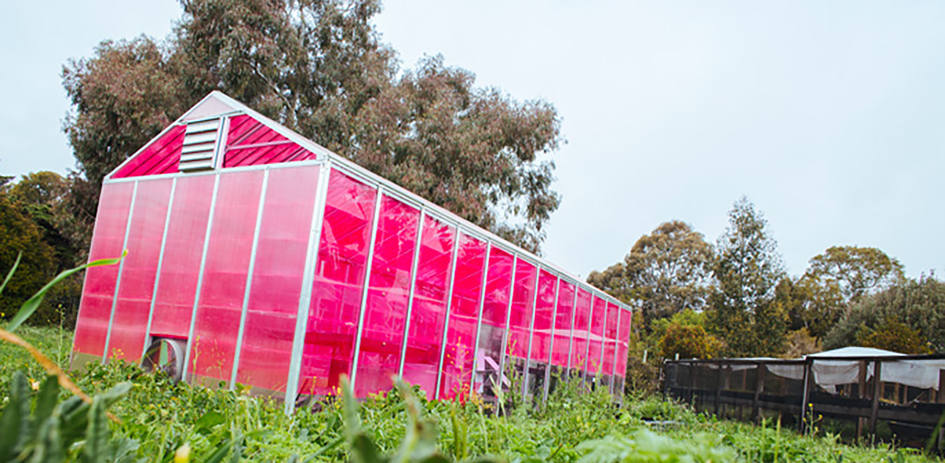Greenhouses have a long list of benefits: – but there’s a problem: they’re expensive, both to install and to operate. But thanks to solar technology developed at University of California Santa Cruz, greenhouses are enjoying a new moment in the sun.
Soliculture, a company based on technology developed in the Thin-Film Optoelectronics Laboratory of physics professor Sue Carter, has been busy explaining to growers the benefits of using their solar panels on greenhouses. “To put it simply, Soliculture panels allow more power, more produce, more profits,” said Glenn Alers, CEO of Soliculture and adjunct professor of physics at UC Santa Cruz.
The panels themselves are not what you expect when you imagine a solar panel: they’re translucent, and they’re a bright shade of magenta.
The idea to apply transparent solar panels to greenhouses came about as a happy accident. Carter and her research team were working on luminescent solar concentrators, which use a fluorescent dye to absorb light and make solar panels significantly more efficient. “The concentrator dye absorbs the sunlight and then re-emits it as lower energy photons. This means you can use a lot fewer solar panels, because the absorber is doing the work,” explained Carter.
No system is perfectly efficient, and there’s always light that doesn’t get used by the solar panel and is lost. In this case, there was something interesting about the rosy-coloured light being lost from the panels they were testing. This light wasn’t waste: it was fuel. “We realized that the red colour of the light was exactly what you see in commercial grow lamps for plants,” Carter said.
Plants don’t use the entire spectrum of visible light for photosynthesis – grow lamps optimize the colours of light that plants actually use to grow. The solar panels developed in Carter’s lab absorbed green light and emitted red light to enhance the power generation of the solar cell – and the excess red light happened to fall exactly in the range of the spectrum that plants use.
The biggest barrier to greenhouse adoption is cost, including the cost of installation and materials, and the ongoing cost to cool, heat and light the greenhouses. Using solar panels to generate electricity dramatically lowers the cost of powering a greenhouse. Carter and Soliculture are working now to show that a fully net-zero greenhouse is possible.
“We’ve recently gotten a lot of interest in our technology in Canada,” said Glenn Alers. “With such a short growing season combined with high electricity rates, the need for panels like ours makes perfect sense.” In the U.S., installing a solar greenhouse makes even more economic sense because they qualify for federal tax breaks aimed at promoting solar power. “California is one of the biggest users of greenhouses in the country – if not the biggest, and it will only get bigger,” said Carter, citing as two drivers the California drought and increased demand for organic produce.
As the price of solar panels continues to drop, crops that were once too costly to grow in greenhouses are likely to take root. Tomatoes and cucumbers are widely grown in greenhouses now, but lettuce and other crops could soon find a place there, too. “The strawberry industry is starting to test greenhouses,” said Carter. “They also have the advantage of bringing the crop up higher, which makes it less physically challenging for pickers.”
In hotter regions, like California’s Central Valley, cooling becomes an issue. Growers use swamp coolers and blinds to block the sunlight. Here again, the colour of the panels is helpful. Not only do the panels provide electricity to power coolers, but the coloured shading of the panels keeps greenhouses cooler and can eliminate the need for blinds.
“Normally it takes a long time to move from idea stage to market,” said Carter, “but right now a combination of beneficial policy changes, natural disasters, and lifestyle changes are accelerating everything.”
Source: University of California Santa Cruz














